Prologue:
This is a story of 36 hours during two months of wildfires in the interior of British Columbia. Just 36 hours of the ongoing insanity of this crisis that began with a heat dome – a term I’d never heard before – that brought us temperatures of 47.5 C (118 F). Thirty six hours of this ongoing disaster that’s seen two villages burned to the ground, hundreds of deaths at the coast attributed to the heat dome, thousands of people evacuated from their homes, many structures lost, and the devasting loss of forests, wildlife, farm animals, and pets.
But I’m just the average person, trying to keep on with what must be kept on; my home hasn’t been threatened, but I’m living with dense smoke and three massive wildfires burning nearby. Just like the ninety thousand others in my city. Just living an ordinary life with an extraordinary new perspective with every decision made. ‘Do I have the right items packed ready to evacuate?’ Or, how about this; making plans to paddle or hike, and then coming back to the reality that we don’t get to think that way anymore – there is too much smoke. There’s too much smoke to do anything safely. Or enjoyably.
My daughter and two grandkids are leaving town for a holiday, booked months ago, on Vancouver Island. Good fortune that it is one area not inundated with smoke. They were excited. I was travelling with them to hopefully buy a car in Vancouver.
You see, in a constant state of emergency, one realizes that an old car with 300 000 km, might be exactly the thing that kills you if you are trying to escape a wildfire. That one little breakdown could be the end. That’s a bit stressful, so I’ve been on a mission to find a reasonably priced used car that will fit grandkids and camping gear for our adventures, and one that is in excellent condition. Sure, I was thinking about replacing the old car before this crash of our climate, but the state of affairs pushed a decision to be made. Car shopping, which in the past would have been fun, has been stressful. There’s so few used cars available, apparently because there’s a lack of new cars available, so people are keeping their older cars. Yet another impact of our pandemic mess. Even if there were more cars to look at, it’s a chore. It’s a chore to go out in the smoke and do something that requires decision making. When you are chronically on high alert and in an unhealthy, unsafe, environment, you don’t exactly trust that your brain is high functioning. Every decision is just a little bit harder. Never mind that there is constant uncertainty regarding a pandemic looping around in our brains as well.
Even this travel plan is wrought with unusual thinking: If I don’t find a car, then I will have to bus back. The busses have cancelled their social distancing policy and, they advertise, if I want more space on the bus, I can buy two seats. Do they wear masks in the bus now? Is there, or isn’t there, a the fourth wave of the covid pandemic underway? Who knows what’s true, anymore. Will the bus system cancel runs to the interior because it’s a wildfire disaster and dangerous? I just hoped the first car I was going to see would be ideal. If not, I guess I’d figure things out. We always do.
Sunday, August 15, 2021 The 36 hours begins
10 am Sunday morning:
The smoke is brutal in Kamloops. The day feels like the sun forgot to come up on time. The air is brown, tinged with orange. It feels gritty in my mouth. There’s no view of anything beyond a few blocks. We’re in the car ready to head to Vancouver. We’ve arranged for a friend to check in on the bunnies each day.
The grandgirls do not know that, early this morning, I’ve delivered the essential items that must be saved in case of fire to that same friend. She lives across the river and is probably safer. I’ve delivered the external drives, the computer, a few albums, one persian rug. The grandgirls do not know I also snuck all of their items they have had stacked in a corner ‘to be saved’ in an emergency. Things that have been packed for almost two months, ever since the first wildfire that threatened one area of the city made us all realize the threat is real. I snuck their boxes of special stuffies, and sentimental items that remind them of their other grandparents who passed away not long ago, Christmas ornaments, and those things that might seem silly to us but are essential to them. I snuck all of this stuff out because, during the night, the winds came up and the wildfire closest to our home travelled 20km in one night. Twenty kilometers in one night. Frightening.
My daughter and I debated whether I should just stay home to keep an eye on things. I chatted with a friend who’s in the know about the reality of these wildfires. The fire was still a long way from Kamloops. My friend guessed that ‘you should be okay but leave like you would if evacuated.’ We figured I could be back the next day, if needed, so we set out. Kids thrilled for a trip. Everyone singing to the current favourite playlist. If the kids had known what we knew, that the fires were more threatening than we knew the day before, they would stress every minute of their holiday. They needed this holiday. Kids, summer, pandemic, smoke. It’s been a shit summer. Okay, not entirely shit. They have had good little getaways to the coast.
10:30 am
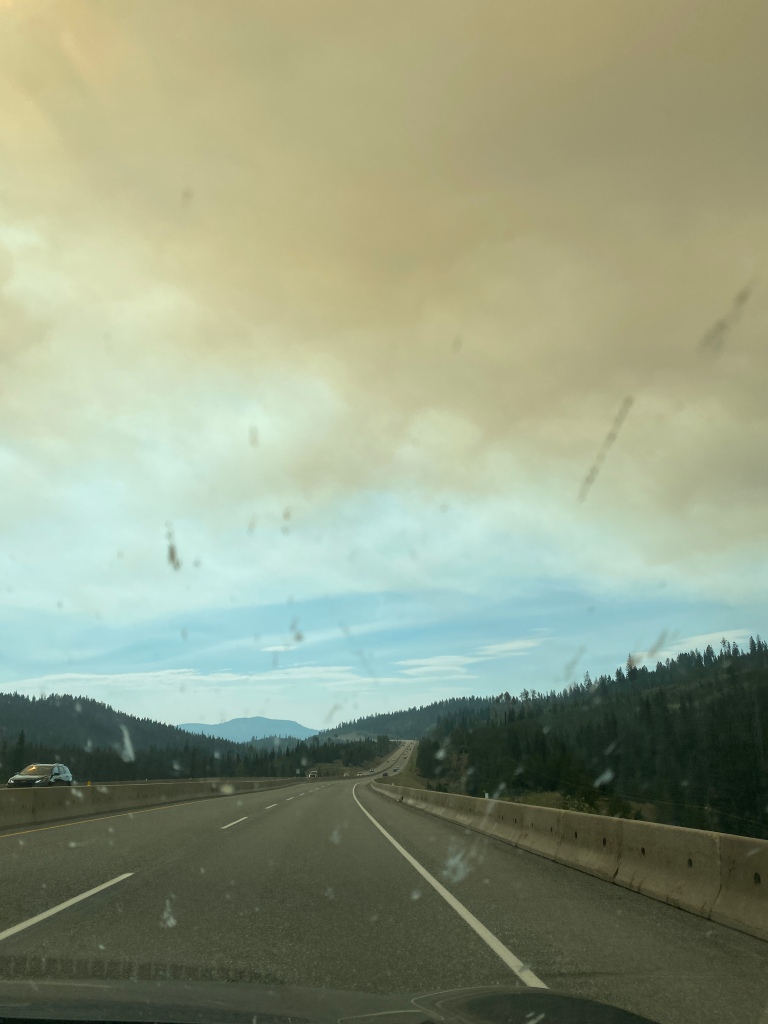
A mere half hour out of town, the sky is blue. The smoke hasn’t just slowly dissipated. There is a distinct line of brown, then blue. I’ve said all along that film makers ought to be gathering footage of all the bizarre sky events – it would make for good background in sci-fi and horror movies. It’s exciting to see, though, that from Merritt onwards is going to be blue skies. And we can breath again! We do normal things, like pull through Starbucks in Merritt for a coffee. There’s no sign of fire, smoke, or holy hellness like in Kamloops. I posted photos to my friends. Just so they knew there was still a blue sky somewhere.
Noon:

Past Merritt, the eeriness begins. Little whisps of smoke, like steam, appear on each side of the highway. Then, an occasional tree is on fire. Not many. We don’t understand how fire works – why are there just these small whisps of smoke and an occasional tree on fire? Is this a new fire? An old fire? We note that a plane is circling the area and we guess that it’s a spotter plane assessing the situation.
Some pylons and signs indicate an accident. Around the corner, in the inside lane, a semi-truck is burning. Firemen are dousing the fire with their massive hose. And what do we think? We think, “Why do semis keep burning this summer?” We don’t think, “Oh my god, a semi is burning!’ That would be the normal response. That would be the big news of a trip in normal times. But now, semis burning are just a sideline in the news, unless that fire is likely to set the forest on fire. Our landscape is tinder to even the tiniest spark. The heat dome prepared it to be that way. Our first thoughts include that we are glad the burning semi-truck is on the inside lane and not near the dried grass on the side of the highway.
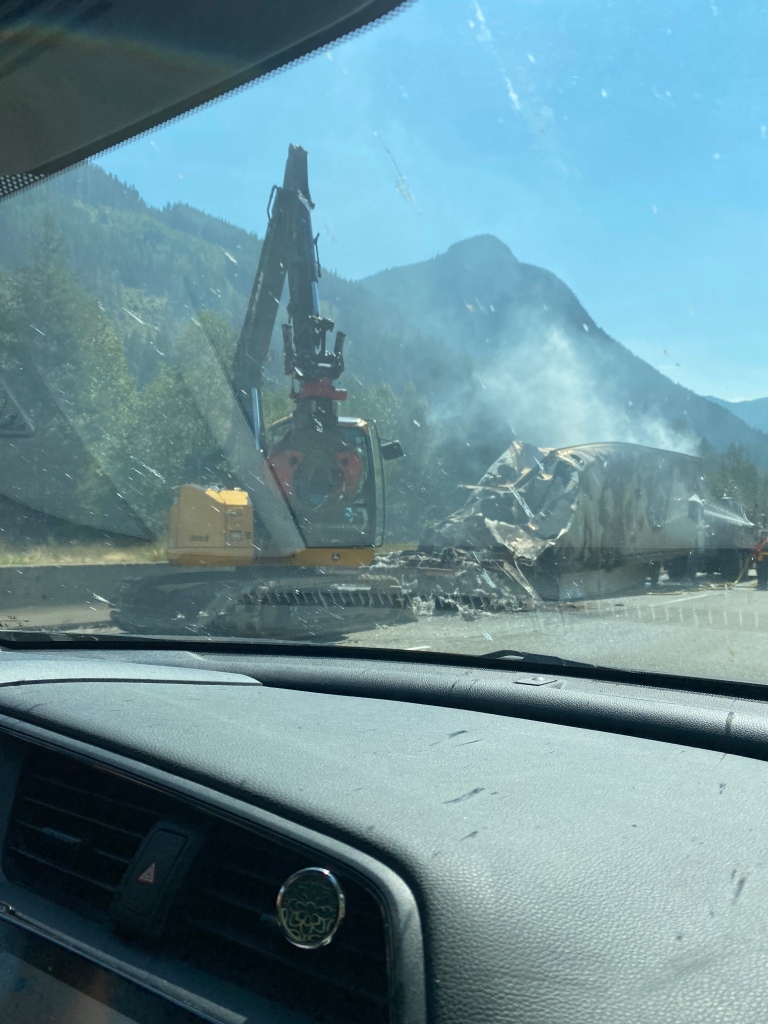
The scattered whisps of smoke, a burning semi truck. Well, isn’t this an apocalyptic scene, I think. ‘Apocalyptic’ shows up in conversations and thoughts a lot these days.
The burning semi-truck really should have been the story we told because it has a touching moment. A grandchild turned to watch the event as we passed.
“Oh my!” She exclaimed, “A firefighter is comforting an older fellow who looks so sad!”
Instead of being desensitized to the whole event, because it’s small in comparison to the rest of the crisis, we were reminded that this semi and its tragic end has affected someone badly. And the firefighters are doing much more than fighting fires.
This is the moment that I recognized how much our thoughts are changing being in this crisis for so long. We normally would have been instantly empathetic to the accident. We also should have been scared by the smoke, but we were not. The sky was blue. There were no big fires showing themselves. The semi was burning in the middle of the road, not on the edge. All was okay.
But all was not okay.
2 pm ish
Vancouver: The family are all delighted to be together again. Cousins and aunties are full of hugs. Though I’ve seen the Vancouver family recently, my daughters hadn’t seen each other for a year, thanks to the pandemic. I love that we are together. I love watching the interactions of these amazing grandchildren and their mothers.
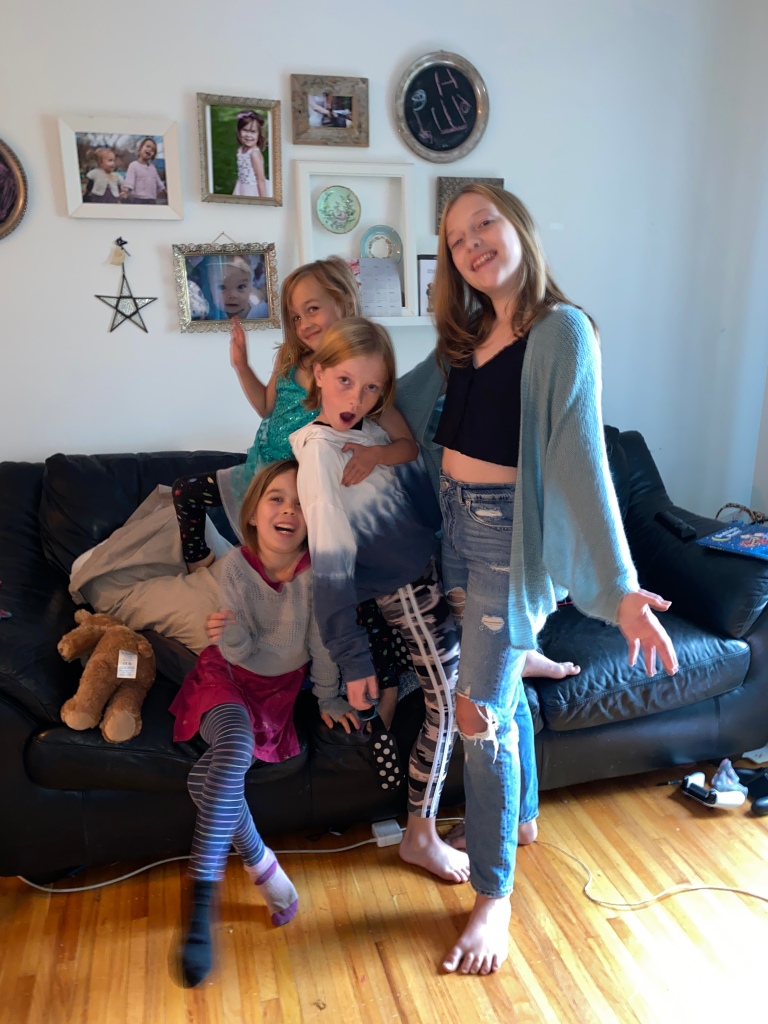
I only have an hour before my son-in-law is taking me to see the potential new car. In that hour, crazy reports are showing up on twitter. As Kamloopsians, we are in the habit of checking twitter, the BC Wildfire site, weather reports, air quality apps, and highway reports on a regular basis. We’ve also learned, by the way, that the apps we count on to inform us and direct us in the most critical moments can fail. On our scariest days so far, these apps have crashed from being overloaded. If you learn nothing else from this story, know that you cannot completely count on emergency alerts or highway reports or regional districts to advise you.
As Kamloopsians, we are on edge checking the fate of the nearby small town of Logan Lake, currently evacuated and directly in the line of fire, literally. But this little town, unlike many who recently thought the climate crisis is a thing ‘on the way,’ Logan Lake has been preparing for years for this event. They’ve fire-smarted their community, including sprinklers on every home as they left. We are all watching and rooting for them.
Between the adults in the room, we are quietly sharing the posts about the insane air quality in Kamloops, and all of the Okanagan. Thick orange-tinged smoke filled skies. Other areas so black in the middle of the afternoon that people have to use their headlights to drive. Street lamps are coming on. We are sharing updates that show wildfires are becoming more threatening to more communities.
I feel strangely guilty for being safe in clean fresh air. I even have a bit of FOMO. Crazy – but here I was, having witnessed two months of the insanity, now missing out on what seemed to be worst day of the crisis. What is wrong with my brain, I wonder.
4 pm
But still, I get to buy a car. The car turns out to be perfect, and we arrange to finish the purchase the next night. There’s a bank draft to get, and the seller has to work, so waiting 24 hours is deemed necessary. I’m pleased with the car, but more than anything, I’m relieved. I will have a car that is more reliable for whatever is needed – escaping fires or camping trips with my grandchildren.
Would I have ever imagined that escaping fires would be a reason to get a reliable car? No. But the climate crisis is here. We now have to keep disaster preparedness in mind for all of our decisions. This is not pessimism or negativity. This is a done deal. This kind of thinking has to be a part of our life planning now. We are no longer trying to prevent a climate crisis. We are in the climate crisis. Best thing we can do is to include it in our planning. I know it’s so easy to watch from a distance and not get it. I’ve watched many disasters from the distance. This is why I’m telling this story. It really is happening.
6 pm
My daughters go out for dinner while I hang out with the kids and son-in-law. The text messages start bouncing between us.
People are posting videos of horrific drives through the Coquihalla – the exact area that we drove through only a few hours earlier. Raging fires on both sides of the roads. Videos are posted full of fear, swearing, panicked voices saying, ‘Hurry, get us out of here.”
Evacuation notices and alerts are being announced for so many areas of the interior that we can’t keep up. A fire starts in the city of Kelowna and an evacuation takes place immediately.
The Coquihalla Highway is soon shut down due to the fire. This is the main highway out of the interior. We cannot even process how those whisps of smoke turned so quickly into a raging inferno.
That stunningly blue-skyed community of Merritt we passed through? Well, now it is on evacuation alert. Plus homes are burning on Okanagan Lake. Small towns are being evacuated. Mines are evacuated.
7 pm
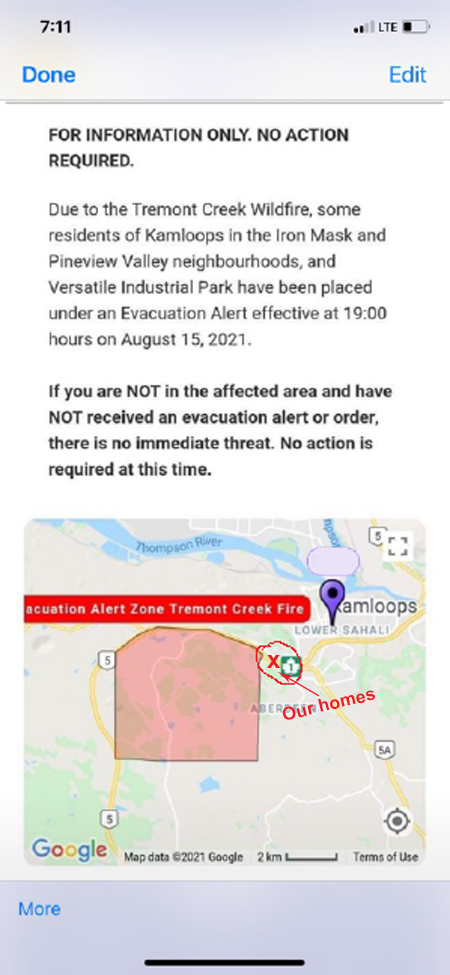
While we are trying to wrap our head around how badly wrong things are going at home, the emergency alert app notifies us that parts of Kamloops are on evacuation alert. The alert boundary is within a kilometre of our homes. Holy fucking hell. We’ve just experienced how fast a bit of smoke and a few trees on fire can turn into something catastrophic. We know that it is not unrealistic that our homes could go up in smoke any time.
Drive BC, the highway app, crashes. There are thousands more people currently being evacuated or put on alert in the last hours. Highways are being closed. And the system we’ve counted on for years to tell us the road conditions, crashes. Twice in the night. They tweet: ‘Oops.’
I don’t know where all these evacuees are going to go. Everywhere is full. I’m kicking myself for not loading up the camp gear, so neatly packed at my door for exactly this kind of situation.
My daughters and I meander outside, so the children don’t hear our conversations.
“Holy crap,” we all agree.
Many ideas are tossed around. Does daughter continue on her holiday? We agree, yes. Her and kids are safe and out of the smoke.
Do I go back and get the bunnies and the stuff out? No, the other highway isn’t doing well either.
“At least we are all together and safe here,” I say.
“My stuff is just stuff, Mom,” One daughter says, “but your stuff – it’s got to be saved.”
Other daughter nods, “You have to get your stuff out.”
So, let me expand on the impact of these comments by my daughters. I’m the keeper of many family treasures – antiques, albums, mementos of loved ones gone – that sort of thing. I’d happily have passed these treasures onto my daughters, (and they do have some) but they are trying to avoid stuff. Stuff and kids just gets overwhelming. When I did a major downsize, they didn’t leap to claim all the treasures. So, I thought they weren’t that concerned about the treasures.
And here I was now, watching the look of concern on my daughters’ faces about the treasures. In this moment, I understood how important these items were. That was heartwarming. Important enough to send their mother back to Kamloops to make sure it was all safe. Ha. Wait? What? Hmmm.
I phone my friend in charge of bunnies. Yes, phone. I actually need a real conversation for this event. It’s hard to make decisions. She offers to go get the bunnies and take them to her house. She’s sure the cats will be fine with it. We laugh.
A few texts follow the phone call: ‘Could you please just take these couple items from my daughter’s house, as well? The M.C. Escher print? And her work computer?’ Not only does she agree to this, her and her family go to my place, too, to get more of my items as well. You know, so my daughters don’t have to worry about all the treasures being lost and all. It’s not hard to figure out what they should grab. I have post-its on things. I put those on at the beginning of the wildfires, just in case an evacuation happened, I wouldn’t miss grabbing as many of the important things as I could.
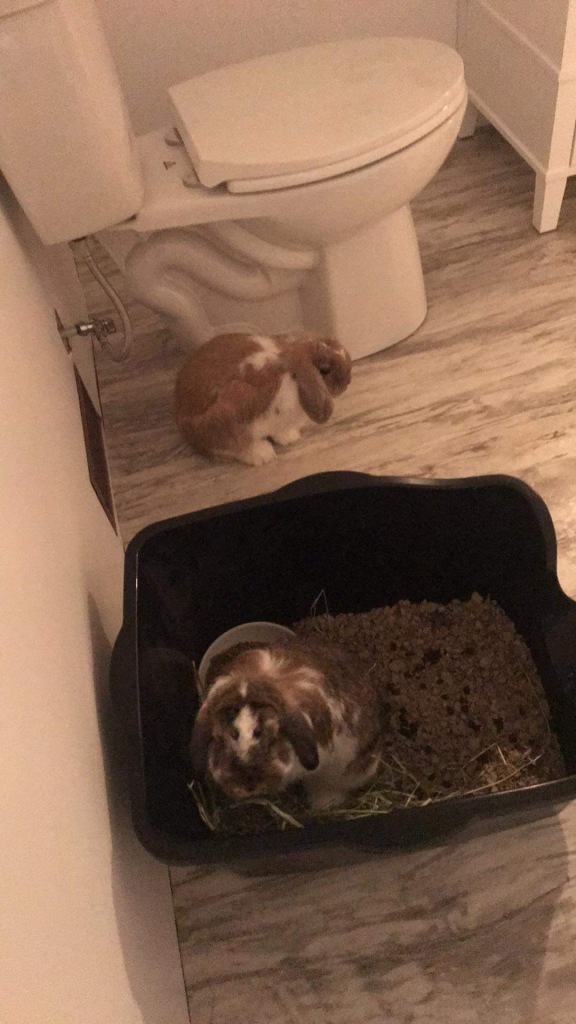
I text the fellow I’m buying the car from:
Hi Ray, An evacuation alert has been issued a km from my home. It’s a very bad day in Kamloops and area and on the highways. I do want to head back as soon as possible and I can wait till after we do all the transfers on the car, but if it is at all possible to do that earlier in the day, please let me know. Hard to say if I can even get through on the highways but if I could, I would go to pack more things from home. Thanks.
Ray figures out a way for me to pick up the car the next morning.
9 am Monday.
After a mostly sleepless night, with constant check-ins on how the crisis is evolving at home and on the highways, I set out with my daughter to get a bank draft, sign papers, get insurance and pick up my new car. I’m grateful for the seller’s empathy and help.
Other daughter and kids head off on their vacation. Am I jealous they get to go on a ferry and smoke-free vacation? Yup. But delighted they get to, as well. Still, my stomach lurches in dread as I imagine having to go back to Kamloops where the air pollution index has been off the charts for 2 months.
No sooner is the new car in my possession than the rains begin. A massive downpour. I send the downpour thoughts to take its rain to the interior.
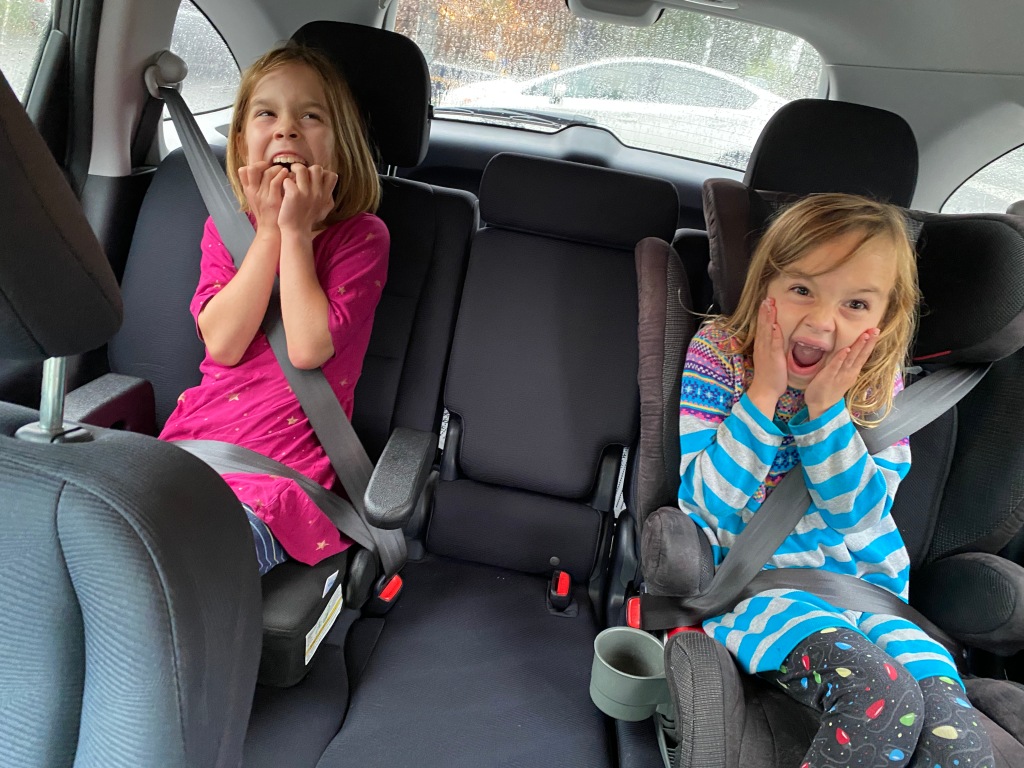
My youngest grandgirls get the first ride in the new car. They are pure joy, laughing and leaping about excitedly. Kids. Always highlighting the good in the world.
3 pm
I’m on my way home. In Hope, I check Drive BC. It tells me that I have to take the Princeton Highway – which, for god’s sakes, takes days. My brother had been checking in with me and said his wife got through on Hwy 1. A shorter route than the one the app insists on, but not as quick as the currently closed Coquihalla that we usually travel. I phone my sister-in-law. Sue says she got through a few hours earlier on Hwy 1, easily enough. ‘Well, there was that one spot that required a police escort through a fire zone, but otherwise okay.’ So, I head that way. Imagine that a police escort through a burning hell hole seems like the best option. Perspectives change when you’ve had so many crises, I guess.
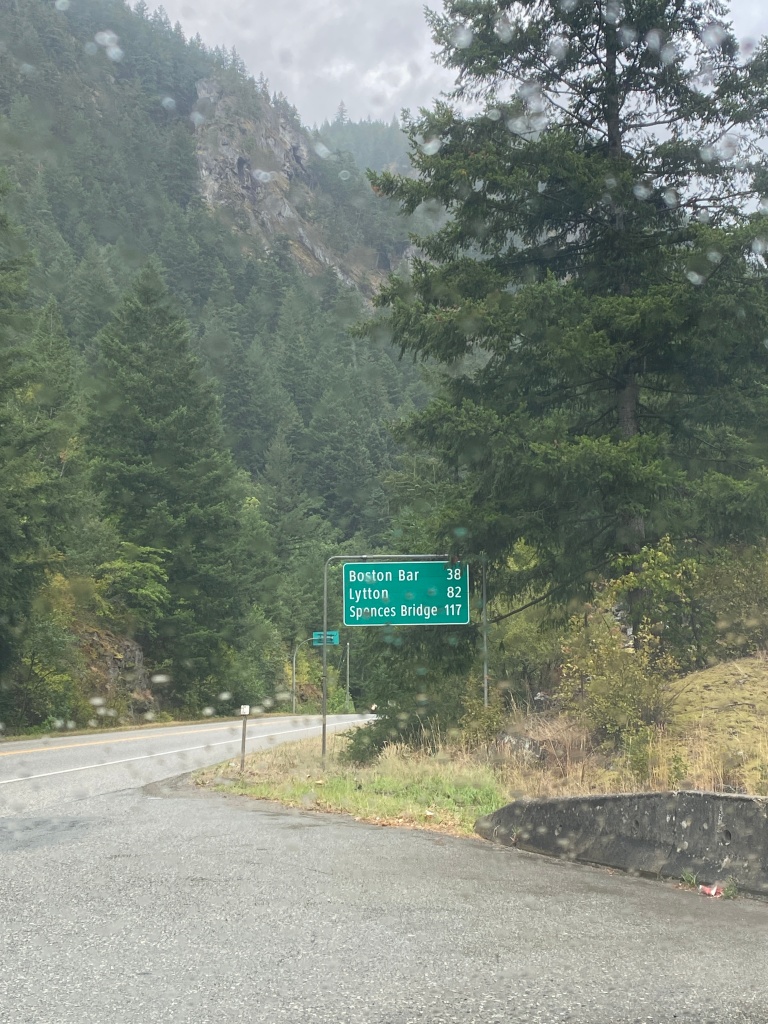
It’s been years since I travelled this route – the first part is stunningly beautiful; full of mountains, and rivers and fabulous tunnels. They were always an adventure for my brothers and I when we were little and off on a family vacation. Best of all, it was still raining. I willed the rain to follow me all the way home.
The rain came down even harder. I’m pretty sure I had a smirk on my face the whole time. But, as I passed by Lytton, the apocalyptic thoughts weighed in. A part of me still thrilled the rain was drowning out fires, but this little town – this is the town that became internationally famous in June. The heat dome took the temperatures there to 50C (122F). The whole world heard about it. I had joked with a family I met from there that now they were internationally famous. The next day the town burned to the ground. In a matter of an hour. Devastated.
Even believing I was on Earth became challenging as I drove through this area. The landscape was ash grey and white. Toothpicks of grey trees looked more like spikes coming from the ash, than anything that was once a beautiful tree. The rain was getting heavier, but the smell was not something I’ve smelled before. A humid steam of heavy smoke. It was suffocating.
The main area of Lytton is not right on the highway, but I saw this: What was once a gas station or store burned to the ground, and not that far along, one that survived. Fire does not do what seems logical. We are learning that this summer. Part of our immediate concerns for our homes is that there’s a bit of forest behind both of our homes. Just a bit. All it would take is one burning ember to set that ablaze, while leaving other areas closer to the fire possibly safe. But still, those few places that survived the Lytton fire – it’s incomprehensible how that happened when one witnesses the absolute devastation in the area. My heart aches for those who lost so much and for those who died.
I will never forget the moments driving through this area, the rains so heavy that my windshield wipers struggle to keep up. I ask my car what it thinks of its new life. Previously it had hardly been driven and, of those miles, mostly back and forth to work in Vancouver. Welcome to life with Janet, new car. We do do adventures. But this is not exactly ideal. This is an unrealistic sci-fi story I’m in. Wait, no, the rain is ideal. I’m still smiling because it’s following me home.
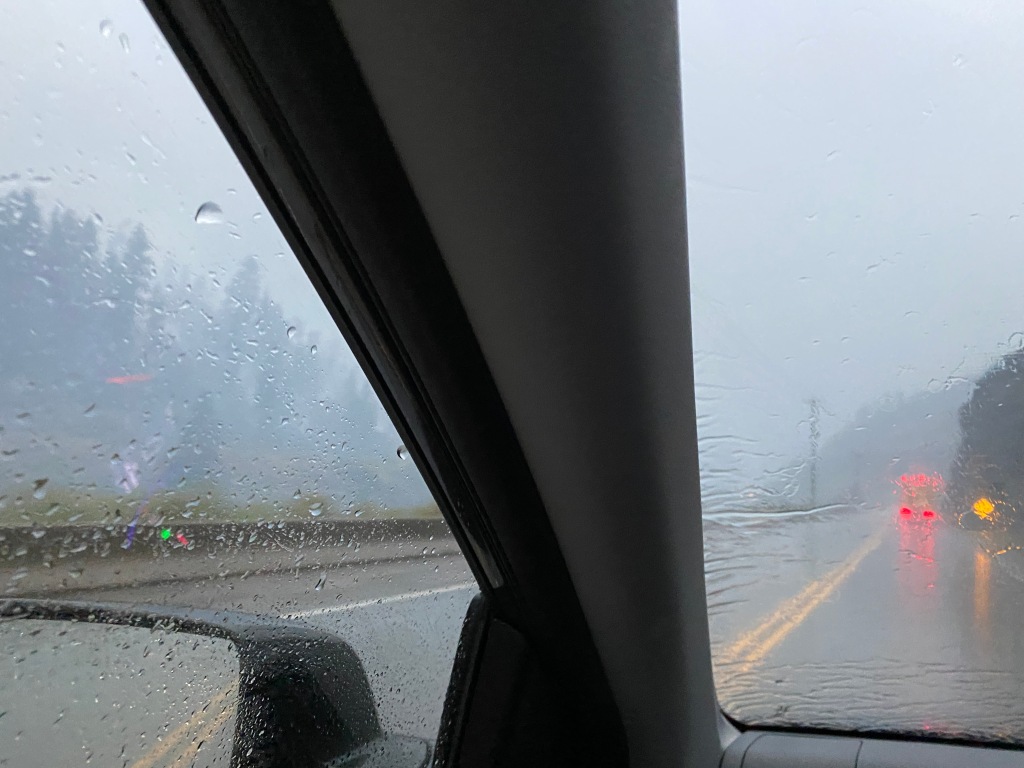
The drive is slow. This two-lane highway is full of semi-trucks that have no other route to take. The oncoming semis drown my car in their wake. I try to stay back from the semis in front of me, so I have at least some visibility. The evening sky is weirdly dark with the ashen steaming smoke and stormy rain.
Still, by nature, I adore driving in a storm. This is the challenge of this 36 hours. Processing joy and disbelief and tragedy all at the same time. This is the challenge every day, it seems.
I carry on as night finds its way through the smoke that stays with me for the rest of the trip. A convoy of army trucks are on the highway. When have I ever seen that? I think I have, but I can’t remember when. Every side road has a blockade stopping people from travelling off the highway. They also have a car with one person sitting there to make sure nobody tries to cross the barriers. I feel like I’m in a war zone.
And finally, it’s 10 pm. I’m home.
I get a text: “Are you okay?”
“Yup, I’m home.”
“Good. Mudslides just closed the road you were on. You just made it through.”
Not just one mudslide, but two. Turns out a burned out dried landscape cannot absorb all that rain. Sigh.
And that’s how my 36 hour story ends. Home safe. No real big deal, to be honest. So many people, so many homes, so much land, and so many animals have been impacted in a way that I have not. I’m okay. My family is okay. My home is okay. The bunnies are okay. I’m just an ordinary person living in a climate disaster and this is how 36 hours can play out.
It’s exhausting. It’s real. It’s not going away. The climate crisis is here. It’s everywhere.
My take is that now is the time to invest in all that we need to survive. Priorities like firefighting and emergency resources and equipment; more wildfire fighters and emergency personnel trained, paid well, treated fairly, with shift changes that give them proper rest; air conditioning systems for everyone; power grids that can handle the demand on the systems… the list goes on.
And of course, reliable vehicles. I honestly still find it hard to believe I bought a new car with ‘reliable escape vehicle’ being a motivation.
But, I did. The world is a little crazy these days, isn’t it? Grateful for the joyful moments and the precious moments that keep me emotionally afloat. I hope you have many of those moments to keep you going through the ongoing stresses of our times.